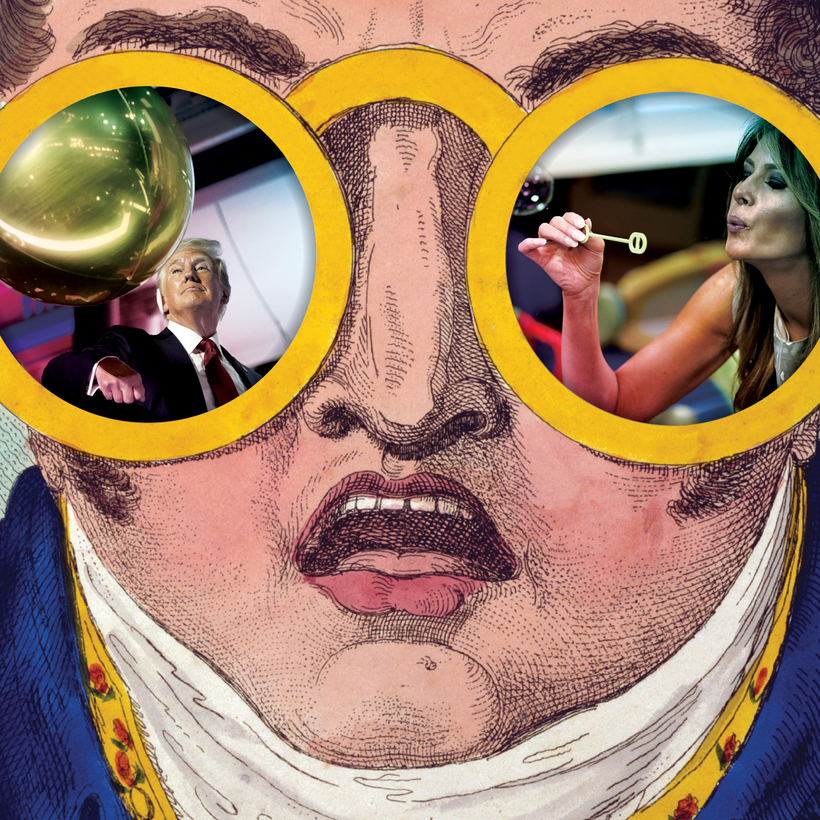On inauguration weekend, the president and First Lady launched the $TRUMP and $MELANIA tokens, a pair of crypto-currencies that had little to distinguish them except their association with the first family—worthless meme coins, in other words. (Or, to the less charitably minded, “shitcoins.”) But because it was Trump, the tokens briefly exploded in value, accumulating billions of dollars in market capitalization, at least on paper, before the inevitable crash. The Trump family reportedly made at least $100 million from trading fees.
There is nothing new—no technical or financial innovation—in Trump’s crypto portfolio. He’s simply slapped his name and likeness on as many crypto ventures as possible while taking majority ownership in the companies behind them.
His foray into crypto may represent the biggest financial scandal in presidential history—a farrago of conflicts of interest, quid pro quos, and even what Democratic senator Chris Murphy has called “a backdoor bribery scheme.” As if on cue, Trump declared this week that the top 200 holders of his $TRUMP token would have the opportunity to hobnob with him at an intimate private dinner.
In the first 100 days of his second term, Trump has unleashed so much chaos—tariff and stock-market panic; a legal and financial war with elite universities; a mass-deportation regime plucking grad students off the streets for writing pro-Palestinian op-eds—that these events have all but eclipsed the first family’s stunningly brazen descent into graft. (And it’s not just crypto: Melania Trump received a $40 million documentary deal from Amazon, reportedly negotiated with Jeff Bezos over dinner at Mar-a-Lago.)
During his first term, Trump critics piously cited the emoluments clause as forbidding foreign elites from spending money at Trump’s D.C. hotel. This could be a breach of norms and ethics, and possibly the law, far beyond that: a potential tidal wave of self-dealing compared to the mere trickle of money that came in during Trump’s first term.
Trump’s World Liberty Financial company, which promises to launch a “decentralized finance” trading platform, has become the veritable bagman for international elites who want to put money in the president’s pocket. Recently, DWF Labs—a crypto market-maker firm with a Russian C.E.O., U.A.E. headquarters, and Swiss business registration—announced a $25 million investment.
Justin Sun, a peripatetic Chinese crypto entrepreneur, invested $75 million in two separate, highly publicized transactions. The Securities and Exchange Commission then paused a fraud investigation into him. The deal was such a smash that, according to The Wall Street Journal and Bloomberg, Binance, the world’s largest crypto exchange, was seeking a similar deal in order to wipe away its co-founder Changpeng Zhao’s guilty plea over money-laundering and sanction violations. Zhao denied that he was seeking such a deal on X. (Binance had also agreed to pay $4.3 billion, the largest fine in U.S. Treasury history.)
Team Trump and its associates seem to be stepping up their efforts to cash out some short-term gains. A crypto wallet connected to the $TRUMP project recently moved $4.6 million worth of tokens, with the apparent intention of selling them on Coinbase.
This month, the analytics firm Bubblemaps found that the team behind $MELANIA had moved approximately $30 million worth of the tokens. The sum was supposed to be “community funds,” essentially a community chest that would provide liquidity and support the development of the token. But with a meme coin, there is no development, no second act. Once you’ve wrung as much value as you can from hapless speculators, there’s nothing more to do—except to cash out.
Still, as Bubblemaps noted, there’s more to come: 92 percent of $MELANIA tokens are owned by the team behind the project—an incredibly lopsided ownership distribution that creates ideal conditions for fleecing MAGA retail traders arriving late to the meme-coin party. Like a diamond cartel hoarding gems to drive up prices, the team behind $MELANIA exercises lucrative control over the token supply.
No one has done presidential crypto with the scale, showmanship, and casual success of Donald Trump, but some are trying. Salvadoran president Nayib Bukele made his name internationally by introducing Bitcoin as a second currency, alongside the U.S. dollar. (The initiative failed to catch on, but Bukele has lately made himself useful to Trump with his gulag-outsourcing services.)
In February, Argentinian president Javier Milei, an arch-libertarian who, like Bukele, has made common cause with America’s tech reactionaries and MAGA elites, endorsed a meme coin called $LIBRA, which involved some of the same tools and even individuals behind the $MELANIA and $TRUMP tokens. Milei was pilloried for supporting what looked to many like a scam, with Argentinean legislators recently voting to launch an investigation into the president.
Meanwhile, Ben Chow, the co-founder of Meteora, one of the firms involved with these projects, resigned after being accused of insider trading by SolanaFloor, a crypto-news outlet. One of Chow’s associates, Hayden Davis, gave a hilariously incriminating interview to the YouTube fraud investigator known as Coffeezilla in which Davis admitted to “sniping” his own tokens—rapidly buying and selling them after launch to help drive (and capitalize on) early price action. An Argentine lawyer filed a request for Interpol to issue a red notice for Davis’s arrest.
In April 2022, Central African Republic president Faustin-Archange Touadéra introduced Bitcoin as legal tender, before revoking it a year later in the face of protest. As Touadéra was touting the potential of Bitcoin, he met with Binance C.E.O. Zhao and launched a token called $SANGO, which failed to catch on.
On February 9, Touadéra took another swing with a token called $CAR, which he called “an experiment designed to show how something as simple as a meme can unite people, support national development, and put the Central African Republic on the world stage in a unique way.” The token, which was managed by a state mining firm, was supposed to somehow raise revenue for national development, with Touadéra claiming that the first $50,000 would go to repairing a crumbling school.
The launch was a disaster. A video posted by the president looked cheap and artificially generated, leading some to wonder if it was fake or a scam (beyond the scam inherent in every meme coin). The token’s official X account was suspended. The C.A.R. government then made a new X account, which was also suspended. Links posted by the token’s Telegram channel were flagged for being phishing links. The $CAR token rose to $900 million in market cap before crashing to about $15 million. (Many speculators buying up meme coins know that they’re likely to lose out to the insiders, but it can be tempting to ignore the overwhelmingly negative odds and just go for it.)
While the $CAR token was cratering, an X user pretending to be the president of the Democratic Republic of the Congo announced its own national meme coin. Someone else appeared to launch yet another meme coin called $COMIGEM, which was named after the C.A.R. state-mining firm overseeing the national meme coin.
In the perpetual-motion machine of crypto scams, it’s ever thus: a mirrored fun house of fake and real projects, all of them jumbled together in chaotic markets, making the same claims toward easy profits and financial revolution. Somehow, none of them have yet to work out that way, but for the political elites increasingly getting in on these projects, it can be an extraordinarily lucrative grift.
Having mastered the meme coin game, Trump has broadened his ambitions, launching a stablecoin—a token with a constant value, pegged to the dollar—called USD1. The president who once said that crypto was a threat to the U.S dollar has just proved the point by issuing his own dollar substitute.
Jacob Silverman is a co-author of Easy Money: Cryptocurrency, Casino Capitalism, and the Golden Age of Fraud

